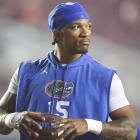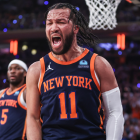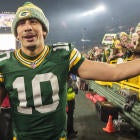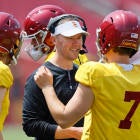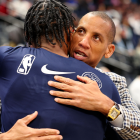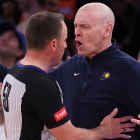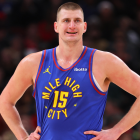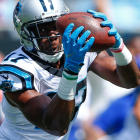
Call me weird as an NFL Draft analyst -- I love pro comparisons. Adore them. Spend way too much time formulating them for prospects every draft season.
Of course, comparisons are always "stylistic" and not solely based on things like height, weight or college program. And because I take them seriously and do so many, many comparisons for prospects aren't exactly superstars at the NFL level.
I will say, in most cases, the top prospects in every class are universally compared to established stars. But even if you follow the draft on a casual level you know -- many first-round picks never reach star superstar status, and in fact, "bust."
With that thought in mind, let's compare the consensus top prospects in the 2023 class to former infamous draft busts. Hat tip to Purple Insider's Matthew Coller for this idea.
(VITAL DISCLAIMER: These are not my legitimate comparisons for these prospects. It's just for fun.)
QB Bryce Young (Alabama)
Bust comparison: Zach Wilson
- Pick and year: No. 2 overall, 2021 draft (Jets)
- College: BYU
Too soon? Yeah, maybe. But it's apt so I'm running with it. Let me explain.
Wilson was a little bigger than Young at 6-foot-2 and 214 pounds but, like Young, he had a narrow-shouldered frame. The two quarterbacks finished their collegiate careers with a similar amount of experience and each had a flair for creative ad-libbing and were deceptively smooth athletes running with the football. Especially in Wilson's final, truly breakout campaign at BYU, when he completed more than 73.5% of his passes with 33 touchdowns to just three interceptions, the young passer threw with pinpoint accuracy and anticipation to all levels of the field.
Wilson wasn't pressured as frequently as Young was in college, yet the poise avoiding pressure and calmness amid the chaos for both quarterbacks made them premier prospects in their respective classes.
DT Jalen Carter (Georgia)
Bust comparison: Marcell Dareus
- Pick and year: No. 3 overall, 2011 draft (Bills)
- College: Alabama
Carter and Dareus are close stylistic specimens, three-down thumpers equally as disruptive as run defenders as they were pass rushers in college. They checked all the boxes teams want out of a marquee defensive tackle prospect.
The off-field concerns run parallel, too. Dareus unfortunately lost many people close to him during his early years and through his time in the NFL, which likely had an affect on him, and thereby shortened what should've been a long, productive NFL career. Conditioning was a problem at times as well. This comparison isn't all bad because Dareus was a first-team All-Pro in 2014 and played in the NFL from 2011 to 2019.
But in a first round with Cam Newton, Von Miller, A.J. Green, Julio Jones, J.J. Watt, and Patrick Peterson, Dareus fell short of the lofty expectations that come with being the No. 3 overall selection in the draft. If Carter never maximizes his full potential as a professional, it'll likely be because of the "character issues" we've heard about at length during this pre-draft process.
QB Will Levis (Kentucky)
Bust comparison: Jake Locker
- Pick and year: No. 8 overall, 2011 draft (Titans)
College: Washington
Thick, physical, rocket-armed quarterback with decision-making and accuracy issues who also boasts serious explosiveness as an emphatic runner when needed. That's the one-sentence scouting report on Locker and Levis. Now, just because their games can be explained with the same quick description, that doesn't mean Levis is destined to be Locker 2.0, who flamed out of the NFL after only 23 starts.
But if Levis flops after being selected in the first round of the 2023 draft, it'll resemble Locker's wade into bust territory. Locker never could string together games with smart decisions. He always trusted his arm too much, and his accuracy was too scattershot. It doesn't feel like Levis is as erratic, but the misses do appear on film, and the athletic profiles and similarly in their running propensity can't be ignored.
QB C.J. Stroud (Ohio State)
Bust comparison: Sam Bradford
- Pick and year: No. 1 overall, 2010 draft (Rams)
- College: Oklahoma
Another selection that wasn't a colossal bust. Sam Bradford won Rookie of the Year in 2010 and led the NFL in completion percentage in 2016. He attempted nearly 3,000 passes and threw for over 19,000 yards as a professional.
But Stroud and Bradford are clearly comparable -- both highly accurate, mostly pocket passers with some mobility, but relative to their eras, are not high-caliber, scrambling types. Like Bradford, it's unlikely Stroud will be able to lean on his legs as a last resort when coverage is perfect or protection breaks down. And the lack of mobility led to many of Bradford's injuries in the NFL; he simply couldn't get out of the way of massive defensive front players and linebackers as often as he needed to. Of course, Stroud doesn't enter the NFL with the injury history Bradford had at Oklahoma, yet despite a long-held thought that athleticism and scrambling represent the strongest correlations to quarterback injuries in the NFL, it's actually the absence of those attributes.
QB Anthony Richardson (Florida)
Bust comparison: Vince Young
- Pick and year: No. 3 overall, 2006 draft (Titans)
- College: Texas
Certainly not as large and sculpted as Richardson, Young was probably a more feared runner when entering the NFL after his illustrious, national-title winning career at Texas. He had back-to-back 1,000-yard rushing seasons and scored 37 touchdowns on the ground with the Longhorns. Preposterous numbers.
Young doesn't have Richardson's arm talent either. Like Richardson, though, it was the needed development as a passer that gave many pause about Young's ability to mature into a franchise quarterback in the NFL and ultimately played a key on-field role to his downfall at the professional level. There were likely other, external, off-field factors that led to Young bouncing around the league before early retirement. He never became a rhythmic, reliable passer. Had he, the 2006 Rookie of the Year likely would've had a long career as the leader of the Titans organization.
RB Bijan Robinson (Texas)
Bust comparison: Trent Richardson
- Pick and year: No. 3 overall, 2012 draft (Browns)
- College: Alabama
Richardson was the man in college. Flat-out, unequivocally, the man. After consecutive seasons reaching the 700-yard mark at Alabama in the early-ish Nick Saban years, Richardson erupted in 2011 with nearly 1,700 yards and 21 touchdowns at close to 5.9 yards per attempt. He was compact, seemingly sculpted from stone, elusive, powerful, and decently fast. In a class that saw Andrew Luck and Robert Griffin III go No. 1 and No. 2 overall, Richardson was universally lauded as a glorious pick by the Browns at No. 3 overall.
After a strong rookie campaign, Richardson's lack of between-the-tackles vision reared its ugly head. Injuries didn't help the developmental process either. Soon he was traded to the Colts and once he ventured into the bust woods, he never returned.
Robinson feels a lot safer than Richardson, right? RIGHT?! No, he is. But there are striking similarities between their frames, their collegiate careers and the adoration of them by the overwhelming majority of draft analysts.
EDGE Will Anderson (Alabama)
Bust comparison: Derek Barnett
- Pick and year: No. 14 overall, 2017 draft (Eagles)
- College: Tennessee
Barnett was hardly a dud in Philadelphia. With the Eagles he registered two seasons with over 40 pressures and had 6.5 sacks in 2019 as a 23-year-old. But there are easy parallels to be drawn between Barnett and Anderson. Both were young, highly decorated, ultra-productive SEC pass rushers who entered the NFL right at about 6-foot-3 and 260 pounds with a slower-than-expected 40-yard dash time at their respective combine.
Anderson was much faster (4.60) than Barnett (4.88). That matters. Their styles on the field were similar in college. Barnett won with deceptive speed and bend around the corner and an NFL-veteran array of pass rush moves. That's the book on Anderson as well. If things go south -- and injuries would almost assuredly need to factor in for this to happen -- Anderson's NFL career could conceivably look like Barnett's in four or five years.












